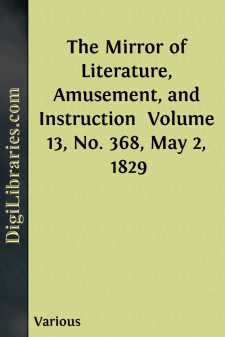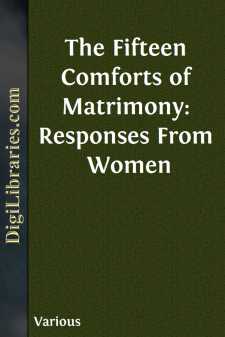Categories
- Antiques & Collectibles 13
- Architecture 36
- Art 48
- Bibles 22
- Biography & Autobiography 813
- Body, Mind & Spirit 142
- Business & Economics 28
- Children's Books 17
- Children's Fiction 14
- Computers 4
- Cooking 94
- Crafts & Hobbies 4
- Drama 346
- Education 46
- Family & Relationships 57
- Fiction 11829
- Games 19
- Gardening 17
- Health & Fitness 34
- History 1377
- House & Home 1
- Humor 147
- Juvenile Fiction 1873
- Juvenile Nonfiction 202
- Language Arts & Disciplines 88
- Law 16
- Literary Collections 686
- Literary Criticism 179
- Mathematics 13
- Medical 41
- Music 40
- Nature 179
- Non-Classifiable 1768
- Performing Arts 7
- Periodicals 1453
- Philosophy 64
- Photography 2
- Poetry 896
- Political Science 203
- Psychology 42
- Reference 154
- Religion 513
- Science 126
- Self-Help 84
- Social Science 81
- Sports & Recreation 34
- Study Aids 3
- Technology & Engineering 59
- Transportation 23
- Travel 463
- True Crime 29
The Mirror of Literature, Amusement, and Instruction Volume 13, No. 368, May 2, 1829
by: Various
Categories:
Description:
Excerpt
CLARENDON HOUSE, PICCADILLY.
The virtuous and uncompromising chancellor, the Earl of Clarendon, had a splendid mansion facing the upper end of St. James's-street, on the site of the present Grafton-street. Of this princely pile, the above is an accurate engraving. It was built by Clarendon with the stone intended for the rebuilding of St. Paul's. "He purchased the materials," says Pennant, "but a nation soured with an unsuccessful war, with fire, and with pestilence, imputed everything as a crime to this great and envied character; his enemies called it Dunkirk House, calumniating him with having built it with the money arising from the sale of that town, which had just before been given up to the French, for a large sum, by his Master."
It is true that Clarendon built this mansion in a season of discontent; but so sensible was he of his vanity and imprudence in building so large a house, and of the envy it drew upon him, that he afterwards apologized for the act; which he declares, so far exceeded the proposed expense, as to add greatly to the embarrassment of his affairs.
This mansion cost £50,000. and 300 men were employed in the building. It was purchased from his lordship by George Monk, Duke of Albemarle, and afterwards by another nobleman, inferior indeed in abilities, but not inferior in virtues. In 1670, James, Duke of Ormond, resided at Clarendon House; and on his way thither, he was one day dragged out of his coach by the infamous Blood and his associates, who intended to hang his Grace at Tyburn, in revenge for justice done, under his administration in Ireland, on some of their companions. "This refinement in revenge," says Pennant, "saved the duke's life; he had leisure to disengage himself from the villain on horseback, to whom he was tied; by which time he was discovered by his servants, and rescued from death."
The original of our Engraving was copied from a rare print, which, in the year 1790, was in the collection of Thomas Allen, Esq. Appended to the former is a section, showing the relative situation of Clarendon House, which was taken from a map of London (supposed to be unique) in an illustrated Clarendon's History, in the possession of John Charles Crowle, Esq. By the section, the entrance-gate to the court-yard of the house appears to have been in Piccadilly, in a direct line with St. James's Street, and the grounds to have extended to Bruton Street at the back, where there was likewise a communication. The site of the front gate is now, therefore, the commencement of Albemarle Street, named after one of the distinguished occupants of Clarendon House.
Notwithstanding the revolutions of time and fashion in this quarter, the illustrious name of the founder of Clarendon House is still preserved in the "Clarendon Hotel," which occupies a portion of the original ground already described. One of the changes is, that instead of the Chancellor meditating upon his dismissal from office, which his very virtues and stately dignity, and a weak king, and a more wicked and envious faction had brought about,—we have well-living twos and fours hob-nobbing over Chateau-Margaux, or yielding to the delightful inspirations of Ay Champagne....












